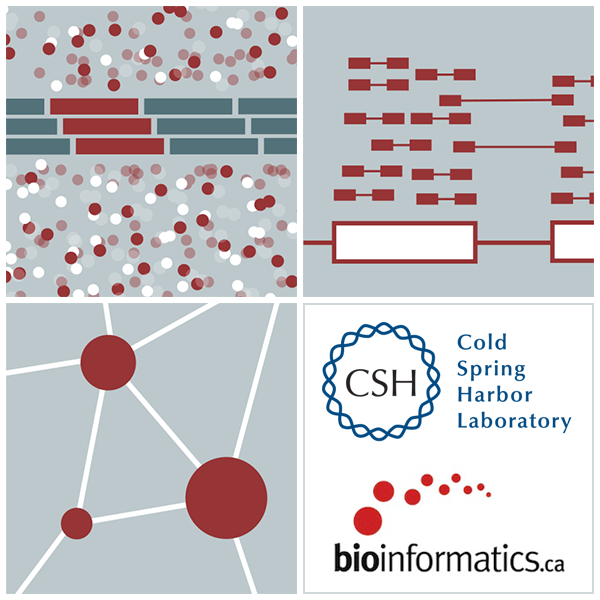High-throughput Biology - From Sequence to Networks 2019 - Integrated Assignment Day 2
This work is licensed under a Creative Commons Attribution-ShareAlike 3.0 Unported License. This means that you are able to copy, share and modify the work, as long as the result is distributed under the same license.
CBW HT-seq Integrative Assignment
Written originally by Mathieu Bourgey, edited by Florence Cavalli and Heather Gibling
Task
We will perform the same analysis as in Module 3, but using the mother and father samples, i.e sample NA12891 and NA12891.
The fastq files are in the following directory of the cloud instance: ~/CourseData/HT_data/Module3/
* raw_reads/NA12891/NA12891_CBW_chr1_R1.fastq.gz
* raw_reads/NA12891/NA12891_CBW_chr1_R2.fastq.gz
* raw_reads/NA12892/NA12892_CBW_chr1_R1.fastq.gz
* raw_reads/NA12892/NA12892_CBW_chr1_R2.fastq.gz
Environment setup
#set up
export WORK_DIR=~/workspace/HTseq/Integrative_Assignment/
export REF=$WORK_DIR/reference/
rm -rf $WORK_DIR
mkdir -p $WORK_DIR
cd $WORK_DIR
ln -s ~/CourseData/HT_data/Module3/* .
singularity run -B ~/cvmfs_cache:/cvmfs-cache/ docker://c3genomics/genpipes:0.7 -V 3.1.2
module load mugqic/java/openjdk-jdk1.8.0_72 mugqic/bvatools/1.6 mugqic/trimmomatic/0.36 mugqic/samtools/1.9 mugqic/bwa/0.7.17 mugqic/GenomeAnalysisTK/4.1.0.0 mugqic/R_Bioconductor/3.5.0_3.7
Task list:
-
Check read QC
-
Trim unreliable bases from the read ends
-
Align the reads to the reference & sort the alignments by chromosome position
-
Realign short indels
-
Mark duplicates
-
Recalibrate the base quality
-
Generate alignment metrics
Discussion/Questions:
-
Explain the purpose of each step
-
Which software tool can be used for each step?
The full commands can be found here, but try to work on it yourself before checking!
Remember to quit the singularity container environment on AWS:
exit
Optional
Perform the same analysis as in Module 4 (SNP calling), but using the mother and father samples, i.e sample NA12891 and NA12891.
#set up
export WORK_DIR=~/workspace/HTseq/Integrative_Assignment/
export REF=$WORK_DIR/reference/
mkdir -p $WORK_DIR/variants
cd $WORK_DIR
singularity run -B ~/cvmfs_cache:/cvmfs-cache/ docker://c3genomics/genpipes:0.7 -V 3.1.2
module load mugqic/java/openjdk-jdk1.8.0_72 mugqic/bvatools/1.6 mugqic/trimmomatic/0.36 mugqic/samtools/1.9 mugqic/bwa/0.7.17 mugqic/GenomeAnalysisTK/4.1.0.0 mugqic/R_Bioconductor/3.5.0_3.7
Some additional things you can look at:
-
If you load up all three realigned BAM files and all three final vcf files into IGV, do the variants look plausible? Use a Punnett square to help evaluate this. i.e. if both parents have a homozygous reference call and the child has a homozygous variant call at that locus, this might indicate a trio conflict. solution
-
Do you find any additional high or moderate impact variants in either of the parents? solution
-
Do all three family members have the same genotype for Rs7538876 and Rs2254135? solution
-
GATK produces even better variant calling results if all three BAM files are specified at the same time (i.e. specifying multiple
-I filenameoptions). Try this and then perform the rest of module 5 on the trio vcf file. Does this seem to improve your variant calling results? Does it seem to reduce the trio conflict rate? solution
Remember to quit the singularity container environment on AWS:
exit
